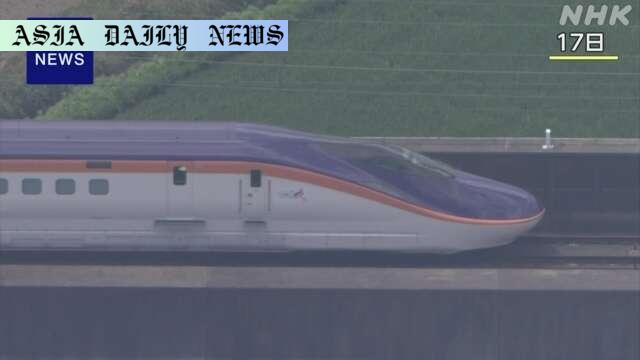E8 Shinkansen encounters multiple issues during test runs, prompting JR East investigation.

Introduction: A Critical Day for the E8 Shinkansen
The E8 Shinkansen, touted as the latest advancement in Japanese train technology, recently encountered a series of disruptions that have raised concerns about its reliability. On a single Tuesday, three significant issues occurred, bringing these modern trains into the spotlight for all the wrong reasons. East Japan Railway (JR East) has confirmed that it will investigate these incidents thoroughly. The incidents not only disrupted commuter services but also posed questions about the manufacturing and operational testing standards of this cutting-edge rail system.
The E8 Shinkansen’s Journey and Purpose
The E8 Shinkansen debuted in March 2022 on the Yamagata Shinkansen line. Designed to offer superior speed, efficiency, and passenger comfort, the train was seen as a symbol of technological progress in high-speed rail systems. Manufactured with state-of-the-art engineering, the E8 series represents JR East’s commitment to maintaining its position as a leader in modern rail travel. However, the incidents that occurred during test runs and operational transit this week suggest there may be flaws in the implementation of the technology, threatening to overshadow the series’ initial promise.
Incident Breakdown: Three Failures in a Day
The troubling chain of events began when an out-of-service E8 series train stopped on the tracks between Utsunomiya and Nasushiobara stations in Tochigi Prefecture. This was followed by a second issue where a test-run train failed to restart after stopping at Koriyama Station in Fukushima Prefecture. Adding to the alarm, another E8 Shinkansen carrying passengers stopped for an inspection in Fukushima City due to an alert indicated on its car monitor system. Collectively, these incidents exposed critical operational vulnerabilities and caused inconvenience for commuters, particularly with the suspension of Tohoku line services between Tokyo and Sendai for over five hours.
Possible Technical Flaws and Manufacturing Questions
It remains unclear what caused these issues, but the fact that they occurred in quick succession has heightened suspicions of underlying technical flaws. Since one of the affected trains was freshly delivered from the car manufacturer and undergoing initial tests, further scrutiny is expected to identify and address these issues at their source. This brings into question whether the trains underwent rigorous enough testing during the production phase. Companies associated with the Shinkansen’s design and manufacture may come under pressure to ensure that these incidents do not repeat.
Implications for JR East and Train Safety
For JR East, the stakes are incredibly high. With its reputation for reliability and innovation in question, the rail operator must act swiftly to restore faith in its services. Safety and operational reliability have always been among Japan’s top priorities in its transport systems, and these incidents threaten to undermine public confidence. Thorough inspections, root cause analyses, and reevaluation of manufacturing protocols must be put in place to ensure that such occurrences do not happen again. The company’s response in the coming weeks will serve as a critical determinant of its credibility in the eyes of the public and its stakeholders.
Conclusion: Lessons to Be Learned
The recent series of failures in the E8 Shinkansen series underline the importance of meticulous planning, testing, and manufacturing in ensuring the successful rollout of technological advancements. While such incidents pose challenges, they also offer a valuable opportunity for improvement. For JR East, addressing these flaws openly and effectively will be essential in regaining the trust of its passengers and continuing its legacy as a leader in rail innovation. In the bigger picture, this serves as a reminder to industries worldwide about the criticality of quality assurance and operational best practices in new technology implementations.
Commentary
Challenges in High-Speed Rail Development
The issues reported with the E8 Shinkansen are both concerning and educational. On one hand, they underscore the complexities of developing cutting-edge transportation systems. On the other hand, they shine a light on the critical importance of rigorous testing and quality assurance measures before deploying such technologies in real-world settings. Although Japan has long been heralded as a pioneer in high-speed rail, these events remind us that even renowned technological systems are not immune to flaws.
Transparency in Addressing Problems
As JR East investigates these incidents, one of the most crucial elements will be transparency. Passengers and stakeholders alike will be looking for clear communication regarding the nature of these issues, the measures taken to address them, and the steps being implemented to prevent recurrence. Openness in resolving problems not only helps rebuild trust but also reflects a company’s commitment to continuous improvement, which is essential in an industry where safety and reliability are paramount.
The Bigger Picture: Innovation vs. Testing
These recent events also highlight the constant tension between innovation and safety in modern engineering projects. Striving for progress often demands risk-taking, but it also emphasizes the need for meticulous testing and a conservative approach to implementation. JR East’s challenges with the E8 Shinkansen could act as a case study for transportation technologies globally, illustrating both the potential pitfalls and the lessons that arise from attempting something new. Striking the right balance between speed of innovation and reliability of execution is not just crucial for JR East but is a guiding principle for all ventures in cutting-edge technology.


